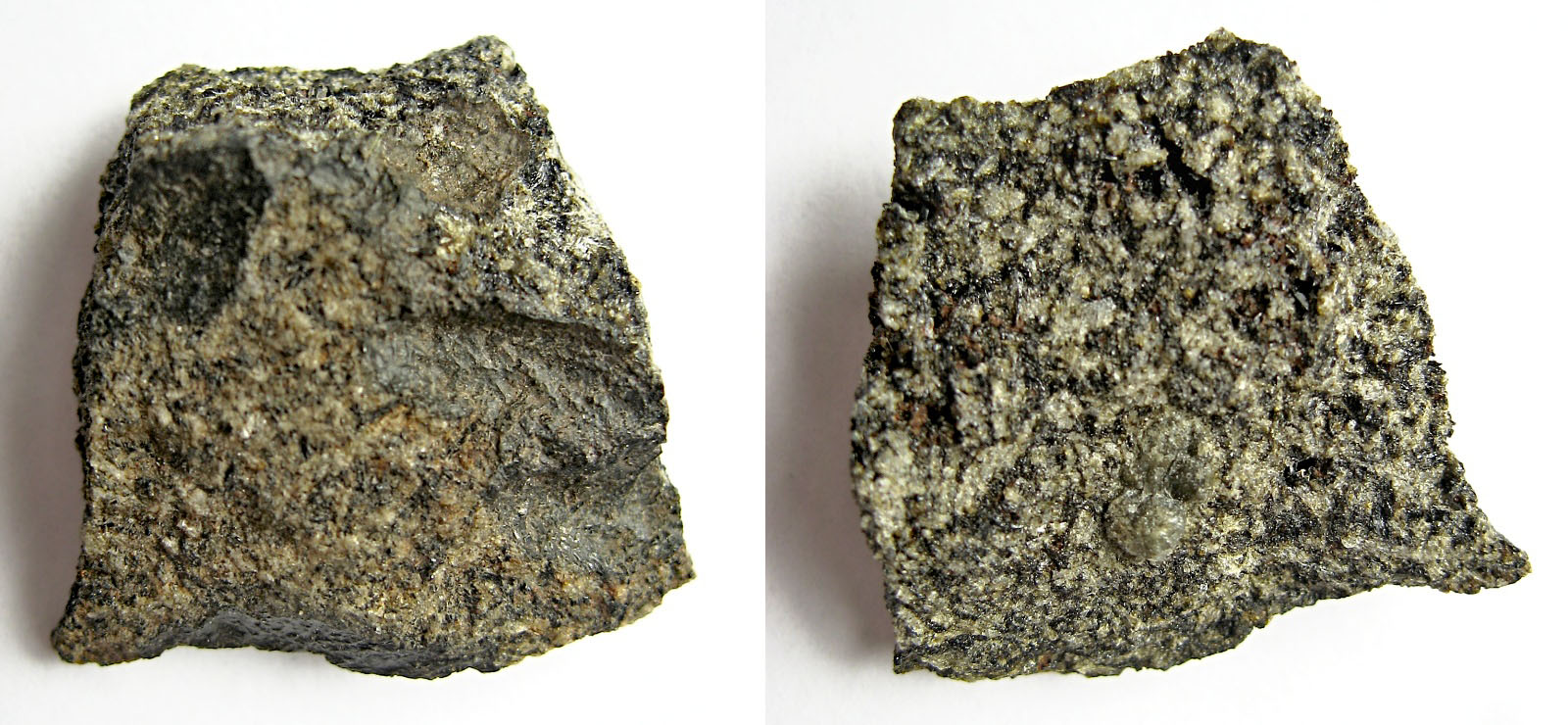|
Roll Overs:
#1
#2
#3
#4
#5
#6
#7
#8
#9
|

|
|
Copyright (c) Steve Brittenham.
|
Angrite
TKW 16.55 kg. Fall not observed. Found July 1979, Buenos Aires Provence, Argentina.
     
Steve writes:
There have been several great d’Orbigny MPOD submissions over the years, including a few recent ones showing both actual pieces and thin section images. I thought I’d add to those with a few more of each, a full slide gigapixel thin section, and some additional information describing this fascinating meteorite.
d’Orbigny is an oriented Argentinian angrite that was found in July, 1979 by a farmhand who struck it with a plow while working an otherwise rock-less field in Buenos Aires. Thinking it was an Indian mortar because of its shield-like shape, he gave it to the landowner, who set it by his house and used it as a door stop for several years. Then in 1998, after reading an article about meteorites, the landowner sent it to several classifiers. Because it was a basaltic rock with no evidence of brecciation or shock metamorphism, all of them dismissed it as being of terrestrial volcanic origin. But in September 2000, Dr. Gero Kurat of the Naturhistorisches Museum in Vienna, Austria made the determination that it was instead a very rare angrite, and an unusual one at that.
Angrites are extremely ancient meteorites, comparable in absolute age with CAIs found in Allende (which are thought to have formed only 3 million years after the first nebular condensates). Isotopic studies suggest angrites are early planetary differentiates, undisturbed since their formation 4.53 billion years ago. But they largely differ in apparent parent body ejection events, as well as cooling processes (some show evidence of rapid cooling, while others were apparently slower).
d'Orbigny has a heterogeneous composition consisting of dense, coarse-grained basaltic textures, as well as porous ones with abundant round vugs up to 2.5 cm in diameter (these vugs are thought originally to have been solid spheres of CaS or nitrides that were subsequently dissolved out through fluid processes). And druses of augite needles, anorthite, and olivine crystals suggest d'Orbigny may not be of a totally igneous origin (d’Orbigny’s trace elements suggest a crystallization history more unique and complex than other angrites). Additionally, while the elemental abundances of d'Orbigny are similar to other meteorites of this type, it has by far the lowest CrO content.
Photo 1 shows the front and back of a small 5.88 gram, 25 mm wide piece from the edge of the meteorite. On it you can see fusion crust and some aerodynamic etching as it fell.
Photo 2 is a larger (38 mm wide) 45.8 gram piece with one sliced and polished edge (not shown), an edge with fusion crust, and other broken edges exhibiting classic spherical vugs, an interesting lined vesicle, and other features typical of this unique meteorite.
Photo 3 is a stereo 3D image of a lined vesicle (just to its right, there is a small augite crystal rising up from the surface); because the depth of focus is poor and the focus is at the surface, Photo 4 is included as a closeup that gives a slightly better view inside (Photo 5 is a red/cyan stereogram version of Photo 4 for those that have difficulty with 3D crossed-eyes images).
Some of d’Orbigny’s spherical vugs are empty, while others are glass-lined. Photo 6 is an animated gif of a rotating x-ray animation created by the Smithsonian several years ago that shows a number of these vugs situated throughout the piece being imaged.
As seen in other MPOD submissions, d’Orbigny can be quite fascinating in thin section, especially when fully imaged, as shown here at GigaPan.
This thin section generally exhibits angular, almost needle-like structures as seen in Photo 7. Photo 8 is a more atypical area, while Photo 9/ shows one of the aforementioned vugs (I’m not sure what the near circular feature to the right of the vug is). |
Click to view larger photos
#1
#2
#3
#4
#5
#6
#7
#8
#9
|
Found at the arrow (green or red) on the map below
|
|
| |
Steve Brittenham
9/19/2020 6:04:06 PM |
John, it's already a problem with people trying to do the crossed-eyes thing! About 10 years ago I had to get prism glasses for cross-eyedness (is that even a word?), which I attribute solely to these 3D pics!! |
John Divelbiss
9/19/2020 2:08:10 PM |
good catch Chauncey...we wouldn't want a MPOD lawsuit like in the movie "The Jerk". :/ |
Steve Brittenham
9/19/2020 11:27:26 AM |
Hi guys. Sorry about the red/cyan image. I'm actually at the Denver show, and I generated that image here without the benefit of red/cyan glasses to check it. The software puts both independent images side by side, and it looked right then, but apparently it wasn't. My apologies. Paul, if you'd like, I can send a corrected image. |
MPOD Moderator
9/19/2020 11:17:42 AM |
@Chauncey: Thanks for pointing this out. I just did a horizontal-flip on photo 5 so we can put our glasses on the correct way now :) |
Chauncey Walden
9/19/2020 10:33:20 AM |
In photo 5 the red/cyan are reversed from normal and must be viewed with the cyan filter on the left eye rather than the standard right. But neat! |
Don Cracraft 2650
9/19/2020 9:30:16 AM |
This was a great contribution to knowledge for us all! |
John Divelbiss
9/19/2020 6:02:25 AM |
awesome specimens and photos Steve...and descriptions too!!! |
| |
|